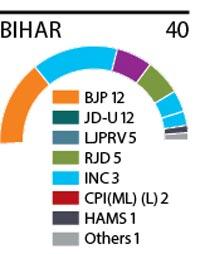Having switched from the INDIA bloc to the BJP only in January this year, will the JD(U)’s Nitish Kumar behave unpredictably, or predictably, to do a palti again?

Nitish Kumar
To observe a wholly Hindi-speaking state from afar, without a recognisable state-level BJP face—despite the ruling party at the Centre, holding Hindi and Hindutva as its main planks in the heartland—might seem odd.
ADVERTISEMENT
There was, of course, BJP’s genteel Sushil Modi, who passed away, shortly before the general elections.
Otherwise, for the last three decades, only two faces have dominated Bihar politics: Lalu Prasad Yadav and Nitish Kumar. National parties have aligned with either dispensation to pick up seats for a coalition. BJP has been a no-go for Lalu. Not so the case with Nitish.
The 2019 general elections in Bihar were different in that regard. There was an evident ‘wave’ for Narendra, the infinitely more popular Modi, nationally, with the BJP bagging 39 of the 40 seats in the state. The only remaining one, Muslim majority, Kishanganj, went to the Congress. As it has in 2024 as well.
The overriding perception for the NDA in Bihar, i.e. BJP with Nitish Kumar’s JD(U), is they were bound to lose seats—having maxed out their potential, and hardly a sign of the same ‘Modi wave’ in 2024, that also rode on the back of the Balakot attacks in 2019. Only the extent of that loss had to be set, depending on the pollster.
That the political formation itself had been formed again did add to some of the confusion.
Nitish’s JD(U) was part of the INDIA bloc, until January 2024, when he suddenly opted out of the coalition government with Lalu’s RJD, returning to BJP, only a few months before the general elections.
The more popular local nickname for Nitish is actually ‘Sushashan’ (good governance) Kumar. His switchover between coalitions, for the eighth time, while retaining the Bihar chief minister’s seat all along, has nationally earned him the sobriquet ‘Paltu’ Kumar. Some predicted a loss of seats for him, along with a loss of face.
It’s only when you visit the state that you realise how the public on the ground often feels differently. As a local wit put it to us during election travels, “How’s Nitish ‘Paltu’ Kumar? He’s exactly on the same seat he was in. It’s the other parties, who keep switching over (for him)!”
An equally defining factor on the ground was young Tejashwi Yadav, to whom father Lalu has totally passed on the reins of the RJD. He was practically the face of INDIA bloc, sharing seats with Congress; together causing a fair dent to the NDA tally.
Likewise, late Ramvilas Paswan’s son Chirag sufficiently delivered seats with LJP for NDA. Which puts into question if there is indeed a resounding public resentment for supposedly dynastic politics in general elections.
Even Tejashwi’s sister, Misa Bharti, got third time lucky, and finally won a seat (from Pataliputra). Expecting the third sibling (Rohini Acharya) to win too would’ve been pushing it, of course. Akhilesh Yadav in the neighbouring UP was fully the hero of 2024.
We guess it depends on the candidates, and the campaign. Tejashwi has doubtlessly been gaining traction since the 2020 Assembly elections—sticking to solving unemployment as his core theme. In a reversed way, these general elections are actually semi-finals for Tejashwi and others preparing for 2025 Bihar polls.
Image makeover for RJD is on. Tejashwi consciously stayed away, for instance, from fielding the former don, Pappu Yadav, from Purnea, in what was the hottest ticket, split three ways in Bihar. Pappu stood as an Independent, and passed with distinction—beating both national formations!
The famed ‘Modi factor’ apart, would the INDIA bloc with Nitish have taken Bihar away from NDA altogether? It would require much splicing of results’ data to arrive at any such conclusion.
That said, it’s hard not to see this as Nitish’s success, in some ways. You could kinda sense it on the streets too, with enough praise still for his work on the state’s law and order.
It’s richly ironic to be warned by local Biharis to be careful with violence, etc., because we were travelling for elections to Bengal next!
There is also Nitish’s long-standing work on creating jobs for women, through subsidised cooperatives, with “Jeevika didis” in every district. In Bihar, the female voter turnout is inevitably higher than the male. By and large, Bihar recorded relatively low voter turnouts, across phases. Which possibly explains fairly predictable results—compared to UP, obviously, that Bihar often gets hyphenated with.
Given that BJP is way short of a majority, and the NDA, precariously, not too far over the mid-way mark itself—the only thing that can make these results less predictable is if Nitish, as an ally with 12 seats, does a ‘palti’ again. Or is that predictable? That’s for the gossip columns, of course.
12
Seats won by JD(U) in Bihar

 Subscribe today by clicking the link and stay updated with the latest news!" Click here!
Subscribe today by clicking the link and stay updated with the latest news!" Click here!







